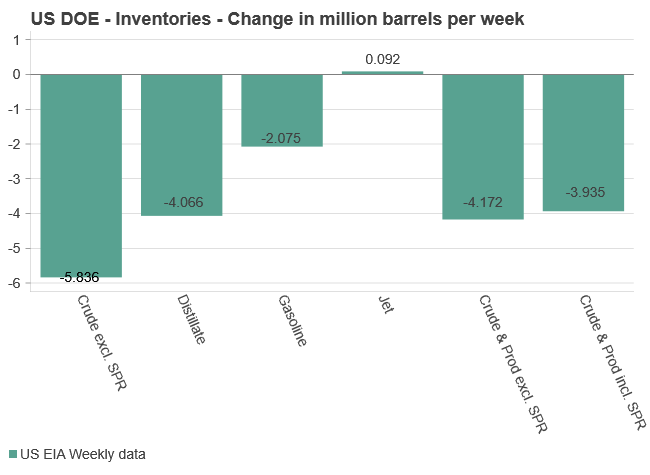Analys
More downside short term – Turn to bullish in mid-November

 Brent crude shed 4.2% yesterday closing at $76.44/bl. It has traded slightly to the upside this morning but more downside seems likely in the short term. Bloomberg consensus is that US crude stocks fell 3.7 million barrels last week with EIA data due today at 16:30 CET. Member data from US API last night however indicated a 9.9 million barrel increase in US crude stocks last week. Over the past three week U.S. crude stocks increased by an average of 7 million barrels per week. Inventories do normally increase at this time of year but only by some 3 million barrels per week as refineries turn around their machines for winter operations. One key reason for the strong increase in U.S. crude stocks currently is the fact that export pipelines are full while domestic production continues to increase. It is thus good reason to expect that U.S. crude stocks continued to increase some 4 million barrels above the seasonal norm. I.e. we should expect data today at 16:30 CET to show a crude stock build of around 7 million barrels last week. This will likely push both the WTI price and the Brent crude oil price further down today.
Brent crude shed 4.2% yesterday closing at $76.44/bl. It has traded slightly to the upside this morning but more downside seems likely in the short term. Bloomberg consensus is that US crude stocks fell 3.7 million barrels last week with EIA data due today at 16:30 CET. Member data from US API last night however indicated a 9.9 million barrel increase in US crude stocks last week. Over the past three week U.S. crude stocks increased by an average of 7 million barrels per week. Inventories do normally increase at this time of year but only by some 3 million barrels per week as refineries turn around their machines for winter operations. One key reason for the strong increase in U.S. crude stocks currently is the fact that export pipelines are full while domestic production continues to increase. It is thus good reason to expect that U.S. crude stocks continued to increase some 4 million barrels above the seasonal norm. I.e. we should expect data today at 16:30 CET to show a crude stock build of around 7 million barrels last week. This will likely push both the WTI price and the Brent crude oil price further down today.
The bearish crude oil price action yesterday was clearly impacted by bearish equity markets, falling 10 year interest rates, rising gold prices and a clear risk-off sentiment. The bearish oil market sentiment was in addition impacted by bearish oil talk by the Saudi Arabian energy minister Khalid Al-Falih who highlighted how Saudi Arabia could increase production both to 11 m bl/d and to 12 m bl/d if needed. The phrasing hade a very clear bearish touch to it in our view.
Mohammed bin Salman (MbS) is in a tough situation at the moment though not at all as tough a situation as Jamal Khashoggi who is actually dead. Since he came to power in 2017 he has consolidated his power, eliminated his rivals and side stepped government institutions and channelled all control into his own hands. MbS has taken very active, direct charge since he came to power (2017). There is no evidence yet tying MbS directly to the liquidation of Jamal Khashoggi though there are probably few who doubt that he was explicitly behind the matter.
MbS is today the ruling prince in Saudi Arabia but he is still not actually the king. He is not either really guaranteed to become the next king. The current ruling king in Saudi Arabia, the 82 year old King Salman bin Abdulaziz Al Saud can still appoint another prince to follow in his footsteps.
As such the communication from the Turkish pm Erdogan is interesting. In yesterday’s media message he did not mention the ruling prince MbS by a word but he praised the ruling king in Saudi Arabia and emphasized that the people behind the killing of Jamal Khashoggi must be taken to court and punished. To us this reads like trying to get MbS out of the way.
MbS today needs his remaining supporters more than ever. His future as king is probably at stake. As such we believe that he now listens much more carefully to Donald Trump’s call for more oil and a lower oil price in the run-up to the US mid-term election on November 6. It is in this context that we interpret Khalid Al-Falih’ bearish oil statement yesterday.
For the time being and the next 2-3 weeks during US refinery turnarounds we’ll have rising US crude stocks. We are also likely to get a further strengthening in the USD (normally strong seasonal dollar gains in November) which likely will hurt emerging market equities and currencies which again is negative for commodities in general. In addition we are also likely to get further bearish verbal intervention Khalid Al-Falih.
We expect most of this to turn to bullish again around mid-November. Donald Trump really wants a fairly high oil price since it creates both US oil independence and a lot of jobs. So after November 6 we are unlikely to hear any more bearish oil talk from him. MbS now also needs a higher oil price more than ever given the loss of friends, supporters as well as backing from international finance so bearish Saudi oil talk should also be a thing of the past. Normally US crude stocks should start to decline again in November though uncertain due to the full export pipelines. In addition the Iran sanctions will likely start to materialize in the form of declining oil inventories some time in November as US sanctions towards Iran fully kicks in on November 4. In general the Brent crude oil market looks tight spot wise but a bearish WTI currently helps to drive all oil benchmarks lower. But contango and rising crude stocks is really primarily in the US.
Analys
Tightening fundamentals – bullish inventories from DOE

The latest weekly report from the US DOE showed a substantial drawdown across key petroleum categories, adding more upside potential to the fundamental picture.

Commercial crude inventories (excl. SPR) fell by 5.8 million barrels, bringing total inventories down to 415.1 million barrels. Now sitting 11% below the five-year seasonal norm and placed in the lowest 2015-2022 range (see picture below).
Product inventories also tightened further last week. Gasoline inventories declined by 2.1 million barrels, with reductions seen in both finished gasoline and blending components. Current gasoline levels are about 3% below the five-year average for this time of year.
Among products, the most notable move came in diesel, where inventories dropped by almost 4.1 million barrels, deepening the deficit to around 20% below seasonal norms – continuing to underscore the persistent supply tightness in diesel markets.
The only area of inventory growth was in propane/propylene, which posted a significant 5.1-million-barrel build and now stands 9% above the five-year average.
Total commercial petroleum inventories (crude plus refined products) declined by 4.2 million barrels on the week, reinforcing the overall tightening of US crude and products.


Analys
Bombs to ”ceasefire” in hours – Brent below $70

A classic case of “buy the rumor, sell the news” played out in oil markets, as Brent crude has dropped sharply – down nearly USD 10 per barrel since yesterday evening – following Iran’s retaliatory strike on a U.S. air base in Qatar. The immediate reaction was: “That was it?” The strike followed a carefully calibrated, non-escalatory playbook, avoiding direct threats to energy infrastructure or disruption of shipping through the Strait of Hormuz – thus calming worst-case fears.

After Monday morning’s sharp spike to USD 81.4 per barrel, triggered by the U.S. bombing of Iranian nuclear facilities, oil prices drifted sideways in anticipation of a potential Iranian response. That response came with advance warning and caused limited physical damage. Early this morning, both the U.S. President and Iranian state media announced a ceasefire, effectively placing a lid on the immediate conflict risk – at least for now.
As a result, Brent crude has now fallen by a total of USD 12 from Monday’s peak, currently trading around USD 69 per barrel.
Looking beyond geopolitics, the market will now shift its focus to the upcoming OPEC+ meeting in early July. Saudi Arabia’s decision to increase output earlier this year – despite falling prices – has drawn renewed attention considering recent developments. Some suggest this was a response to U.S. pressure to offset potential Iranian supply losses.
However, consensus is that the move was driven more by internal OPEC+ dynamics. After years of curbing production to support prices, Riyadh had grown frustrated with quota-busting by several members (notably Kazakhstan). With Saudi Arabia cutting up to 2 million barrels per day – roughly 2% of global supply – returns were diminishing, and the risk of losing market share was rising. The production increase is widely seen as an effort to reassert leadership and restore discipline within the group.
That said, the FT recently stated that, the Saudis remain wary of past missteps. In 2018, Riyadh ramped up output at Trump’s request ahead of Iran sanctions, only to see prices collapse when the U.S. granted broad waivers – triggering oversupply. Officials have reportedly made it clear they don’t intend to repeat that mistake.
The recent visit by President Trump to Saudi Arabia, which included agreements on AI, defense, and nuclear cooperation, suggests a broader strategic alignment. This has fueled speculation about a quiet “pump-for-politics” deal behind recent production moves.
Looking ahead, oil prices have now retraced the entire rally sparked by the June 13 Israel–Iran escalation. This retreat provides more political and policy space for both the U.S. and Saudi Arabia. Specifically, it makes it easier for Riyadh to scale back its three recent production hikes of 411,000 barrels each, potentially returning to more moderate increases of 137,000 barrels for August and September.
In short: with no major loss of Iranian supply to the market, OPEC+ – led by Saudi Arabia – no longer needs to compensate for a disruption that hasn’t materialized, especially not to please the U.S. at the cost of its own market strategy. As the Saudis themselves have signaled, they are unlikely to repeat previous mistakes.
Conclusion: With Brent now in the high USD 60s, buying oil looks fundamentally justified. The geopolitical premium has deflated, but tensions between Israel and Iran remain unresolved – and the risk of missteps and renewed escalation still lingers. In fact, even this morning, reports have emerged of renewed missile fire despite the declared “truce.” The path forward may be calmer – but it is far from stable.
Analys
A muted price reaction. Market looks relaxed, but it is still on edge waiting for what Iran will do

Brent crossed the 80-line this morning but quickly fell back assigning limited probability for Iran choosing to close the Strait of Hormuz. Brent traded in a range of USD 70.56 – 79.04/b last week as the market fluctuated between ”Iran wants a deal” and ”US is about to attack Iran”. At the end of the week though, Donald Trump managed to convince markets (and probably also Iran) that he would make a decision within two weeks. I.e. no imminent attack. Previously when when he has talked about ”making a decision within two weeks” he has often ended up doing nothing in the end. The oil market relaxed as a result and the week ended at USD 77.01/b which is just USD 6/b above the year to date average of USD 71/b.

Brent jumped to USD 81.4/b this morning, the highest since mid-January, but then quickly fell back to a current price of USD 78.2/b which is only up 1.5% versus the close on Friday. As such the market is pricing a fairly low probability that Iran will actually close the Strait of Hormuz. Probably because it will hurt Iranian oil exports as well as the global oil market.
It was however all smoke and mirrors. Deception. The US attacked Iran on Saturday. The attack involved 125 warplanes, submarines and surface warships and 14 bunker buster bombs were dropped on Iranian nuclear sites including Fordow, Natanz and Isfahan. In response the Iranian Parliament voted in support of closing the Strait of Hormuz where some 17 mb of crude and products is transported to the global market every day plus significant volumes of LNG. This is however merely an advise to the Supreme leader Ayatollah Ali Khamenei and the Supreme National Security Council which sits with the final and actual decision.
No supply of oil is lost yet. It is about the risk of Iran closing the Strait of Hormuz or not. So far not a single drop of oil supply has been lost to the global market. The price at the moment is all about the assessed risk of loss of supply. Will Iran choose to choke of the Strait of Hormuz or not? That is the big question. It would be painful for US consumers, for Donald Trump’s voter base, for the global economy but also for Iran and its population which relies on oil exports and income from selling oil out of that Strait as well. As such it is not a no-brainer choice for Iran to close the Strait for oil exports. And looking at the il price this morning it is clear that the oil market doesn’t assign a very high probability of it happening. It is however probably well within the capability of Iran to close the Strait off with rockets, mines, air-drones and possibly sea-drones. Just look at how Ukraine has been able to control and damage the Russian Black Sea fleet.
What to do about the highly enriched uranium which has gone missing? While the US and Israel can celebrate their destruction of Iranian nuclear facilities they are also scratching their heads over what to do with the lost Iranian nuclear material. Iran had 408 kg of highly enriched uranium (IAEA). Almost weapons grade. Enough for some 10 nuclear warheads. It seems to have been transported out of Fordow before the attack this weekend.
The market is still on edge. USD 80-something/b seems sensible while we wait. The oil market reaction to this weekend’s events is very muted so far. The market is still on edge awaiting what Iran will do. Because Iran will do something. But what and when? An oil price of 80-something seems like a sensible level until something do happen.
-

 Nyheter4 veckor sedan
Nyheter4 veckor sedanMahvie Minerals växlar spår – satsar fullt ut på guld
-

 Analys4 veckor sedan
Analys4 veckor sedanA muted price reaction. Market looks relaxed, but it is still on edge waiting for what Iran will do
-

 Nyheter3 veckor sedan
Nyheter3 veckor sedanJonas Lindvall är tillbaka med ett nytt oljebolag, Perthro, som ska börsnoteras
-

 Nyheter3 veckor sedan
Nyheter3 veckor sedanOljan, guldet och marknadens oroande tystnad
-

 Nyheter3 veckor sedan
Nyheter3 veckor sedanDomstolen ger klartecken till Lappland Guldprospektering
-

 Analys3 veckor sedan
Analys3 veckor sedanTightening fundamentals – bullish inventories from DOE
-

 Nyheter2 veckor sedan
Nyheter2 veckor sedanRyska staten siktar på att konfiskera en av landets största guldproducenter
-

 Nyheter2 veckor sedan
Nyheter2 veckor sedanSommarvädret styr elpriset i Sverige








